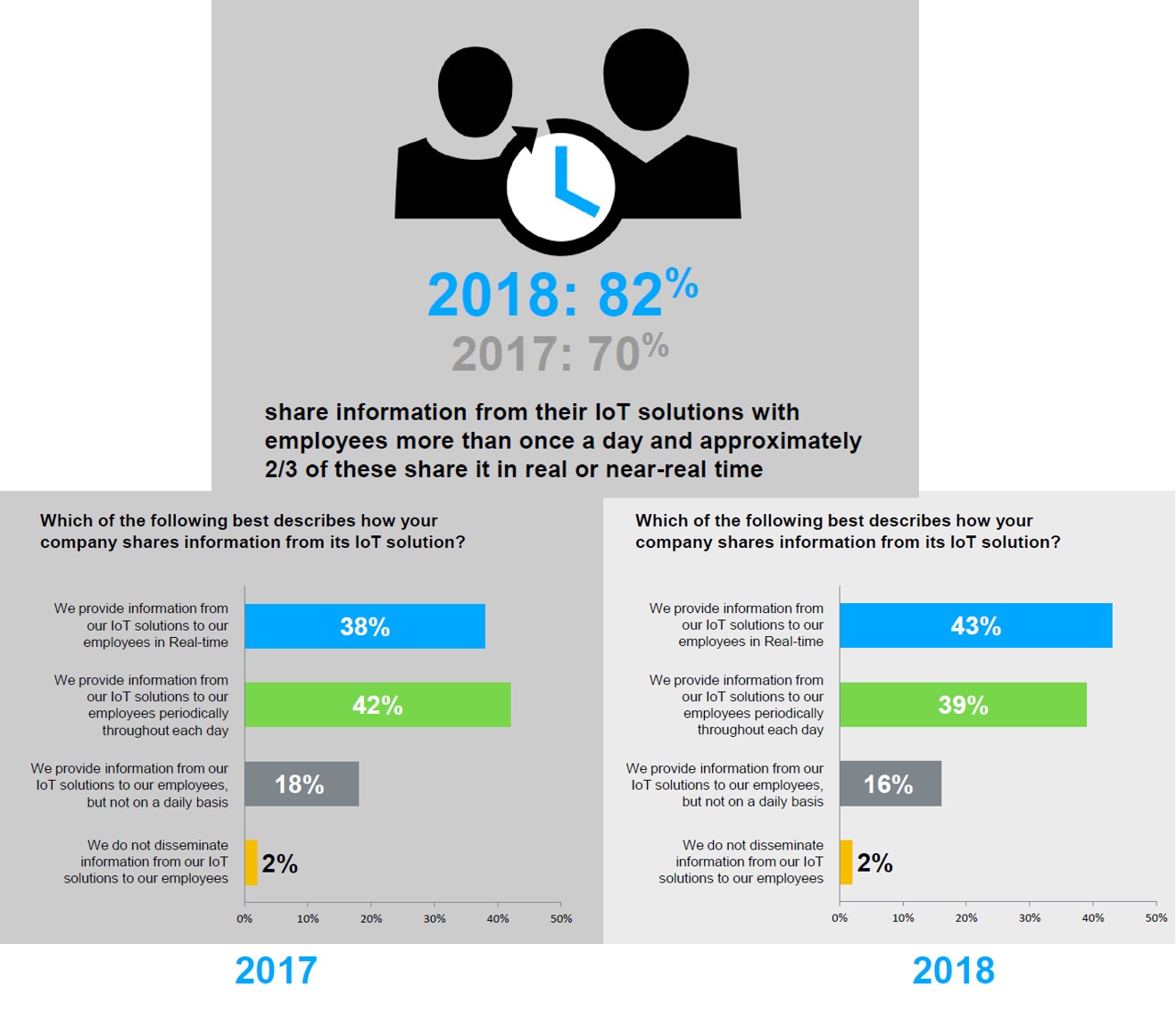
- Enterprises increased their investments in IoT by 4% in 2018 over 2017, spending an average of $4.6M this year.
- 38% of enterprises have company-wide IoT deployments in production today.
- 84% of enterprises expect to complete their IoT implementations within two years.
- 82% of enterprises share information from their IoT solutions with employees more than once a day; 67% are sharing data in real-time or near real-time.
These and many other fascinating insights are from Zebra Technologies’ second annual Intelligent Enterprise Index (PDF, 25 pp., no opt-in). The index is based on the list of criteria created during the 2016 Strategic Innovation Symposium: The Intelligent Enterprise hosted by the Technology and Entrepreneurship Center at Harvard (TECH) in 2016. An Intelligent Enterprise is one that leverages ties between the physical and digital worlds to enhance visibility and mobilize actionable insights that create better customer experiences, drive operational efficiencies or enable new business models, “ according to Tom Bianculli, Vice President, Technology, Zebra Technologies.
The metrics comprising the index are designed to interpret where companies are on their journeys to becoming Intelligent Enterprises. The following are the 11 metrics that are combined to create the Index: IoT Vision, Business Engagement, Technology Solution Partner, Adoption Plan, Change Management Plan, Point of use Application, Security & Standards, Lifetime Plan, Architecture/Infrastructure, Data Plan and Intelligent Analysis. An online survey of 918 IT decision makers from global enterprises competing in healthcare, manufacturing, retail and transportation and logistics industries was completed in August 2018. IT decision makers from nine countries were interviewed, including the U.S., U.K./Great Britain, France, Germany, Mexico, Brazil, China, India, and Australia/New Zealand. Please see pages 24 and 25 for additional details regarding the methodology.
Key insights gained from the Intelligent Enterprise Index include the following:
- 86% of enterprises expect to increase their spending on IoT in 2019 and beyond. Enterprises increased their investments in IoT by 4% in 2018 over 2017, spending an average of $4.6M this year. Nearly half of enterprises globally (49%) interviewed are aggressively pursuing IoT investments with the goal of digitally transforming their business models this decade. 38% of enterprises have company-wide IoT deployments today, and 55% have an IoT vision and are currently executing their IoT plans.
- 49% of enterprises are on the path to becoming an Intelligent Enterprise, scoring between 50 – 75 points on the index. The percent of enterprises scoring 75 or higher on the Intelligent Enterprise Index gained the greatest of all categories in the last 12 months, increasing from 5% to 11% of all respondents. The majority of enterprises are improving how well they scale the integration of their physical and digital worlds to enhance visibility and mobilize actionable insights. The more real-time the integration unifying the physical and digital worlds of their business models, the better the customer experiences and operational efficiencies attained.
- The majority of enterprises (82%) share information from their IoT solutions with employees more than once a day, and 67% are sharing data in real-time or near real-time. 43% of enterprises say information from their IoT solutions is shared with employees in real-time, up 38% from last year’s index. 76% of survey respondents are from retailing, manufacturing, and transportation & logistics. Gaining greater accuracy of reporting across supplier networks, improving product quality visibility and more real-time data from distribution channels are the growth catalysts companies competing in retail, manufacturing, and transportation & logistics need to grow. These findings reflect how enterprises are using real-time data monitoring to drive quicker, more accurate decisions and be more discerning in which strategies they choose. Please click on the graphic to expand to view specifics.
- Enterprises continue to place a high priority on IoT network security and standards with real-time monitoring becoming the norm. 58% of enterprises are monitoring their IoT networks constantly, up from 49%, and a record number of enterprises (69%) have a pre-emptive, proactive approach to IT security and network management. It’s time enterprises consider every identity a new security perimeter, including IoT sensors, smart, connected products, and the on-premise and cloud networks supporting them. Enterprises need to pursue a “never trust, always verify, enforce least privilege” approach and are turning to Zero Trust Privilege (ZTP) to solve this challenge today. ZTP grants least privilege access based on verifying who is requesting access, the context of their request, and ascertaining the risk of the access environment. Designed to secure infrastructure, DevOps, cloud, containers, Big Data, and scale to protect a wide spectrum of use cases, ZTP is replacing legacy approaches to Privileged Access Management by minimizing attack surfaces, improving audit and compliance visibility, and reducing risk, complexity, and costs for enterprises. Leaders in this field include Centrify for Privileged Access Management, Idaptive, (a new company soon to be spun out from Centrify) for Next-Gen Access, as well as Cisco, F5 and Palo Alto Networks in networking.
- Analytics and security dominate enterprise’ IoT management plans this year. 66% of enterprises are prioritizing analytics as their highest IoT data management priority this year, and 63% an actively investing in IoT security. The majority are replacing legacy approaches to Privilege Access Management (PAM) with ZTP. Enterprises competing in healthcare and financial services are leading ZTS’ adoption today, in addition to government agencies globally. Enterprises investing in Lifecycle management solutions increased 11% between 2017 and 2018. Please click on the graphic to expand to view specifics.




